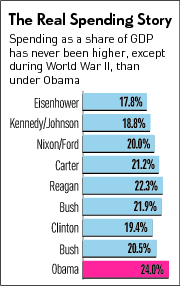Obama is a Spendthrift - And Here's the Proof
IBDEdiorials.com

Budget: You wouldn't think that, after adding $5 trillion to the U.S.' debt, President Obama would seriously claim he's a fiscal hawk. But thanks to a misleading article on CBS' MarketWatch site, that's just what he's doing.
'Since I've been president, federal spending has risen at the lowest pace in nearly 60 years," Obama said on Wednesday. "Think about that."
Obama didn't turn to his own Office of Management and Budget to support this fact, or even the non-partisan Congressional Budget Office.
Instead, he went to a CBS MarketWatch column by Rex Nutting, which claims spending under Obama has risen by an average of just 1.4%.
"Federal spending," he wrote, "is rising at the slowest pace since Dwight Eisenhower brought the Korean War to an end in the 1950s."
Nutting even posted a chart to "prove" his case, which appears to show average annual spending hikes under Obama coming in well under that of his predecessors.
Not surprisingly, this "fact" lit up the left-wing blogosphere, with the White House quickly parading the article to dismiss GOP attacks.
There's just one problem. Nutting had it wrong.
In fact, he made two significant mistakes that have the effect of hiding Obama's huge spending spree, mistakes that even Nutting's conservative critics missed.
The first is that Nutting apparently failed to understand how the government accounted for TARP in the federal budget.
TARP wasn't a spending program. It was a loan to troubled banks that those banks were supposed to pay back, with interest.
Nevertheless, when the government handed out TARP loans in fiscal year 2009, they showed up in the budget as regular outlays, adding $154 billion to the official spending number that year.
And when banks started paying the loans back in 2010, the money was subtracted from spending that year, making federal outlays look $108 billion smaller than they actually were.
In 2011, TARP artificially subtracted another $38 billion from spending, according to the Congressional Budget Office.
Because Nutting didn't factor this in, he ends up greatly exaggerating spending under Bush in 2009 — which Nutting counts as Bush's last budget since the first four months were on Bush's watch — and undercounting Obama's real spending hikes in 2010. (We asked Nutting by email if he was aware of this oversight and have not heard back.)
In addition, Nutting failed to account for the fact that the government was also busy bailing out Freddie Mac and Fannie Mae, with the bulk of the bailout money going out in 2009, and then quickly tapering off in 2010 and 2011. That, too, artificially boosted spending levels in 2009.
In fact, it's because of the unique nature of TARP and the Fannie/Freddie bailouts that the CBO counted them separately in its Monthly Budget Review reports (http://cbo.gov/sites/default/files/cbofiles/attachments/2011_Nov_MBR. pdf) — something Nutting apparently never bothered to check when putting together his bogus chart.
Just how much of a difference does this make?
Nutting says spending under Bush shot up 17.9% between 2008 and 2009.
But when you subtract the effects of TARP, the Fannie/Freddie bailouts as well as the $115 billion in stimulus money Obama added in 2009, that figure drops to 6%.
And while Nutting claims Obama cut spending 1.8% between 2009 and 2010, when you fix Nutting's mistakes, it turns out that Obama jacked up spending 12% in 2010.
That sure looks like a "spending binge" to us.
Another big problem with Nutting's claim is that he didn't adjust his spending numbers for inflation, which makes spending increases look much bigger during higher inflation years.
For example, when you adjust for inflation in Reagan's first term, it turns out that spending climbed an average of just 3.3%, instead of the 8.7% Nutting claims.
When you make all these adjustments, what you find is that only President Johnson beats Obama's three-year spending splurge, and that's because Johnson was implementing his massive Great Society programs while also expanding the war effort in Vietnam.
Of course, much of the confusion about who's a big spender is easily resolved by looking at government spending as a share of GDP, which is the most reliable calculus since it measures government's claim on the entire economy.
In Obama's first term, federal spending will average 23.8% of GDP, according to the CBO.
For those keeping score, that's higher than it's ever been since World War II. And it's more than twice as high as it ever got during the Great Depression.
So much for the claim that Obama isn't a big spender.
It's bad enough that we have to deal with Obama's constant efforts to distort his own dismal record. It's far worse when members of the mainstream press do his dirty work for him.

